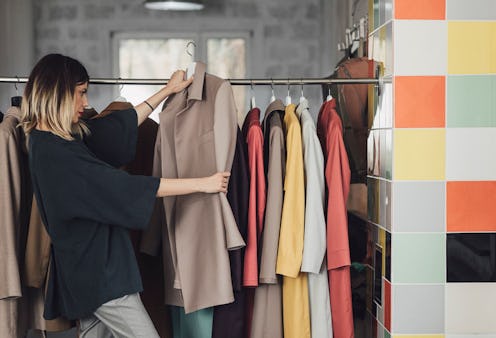Fashion
This Simple New Shopping Strategy Will Help You Do Your Bit To Save The Planet

Over a week ago, activist group Extinction Rebellion started its international climate change protest. April 24 will mark the sixth anniversary of the Rana Plaza factory collapse in which 1,138 garment workers were killed. Combine public feeling around these two events and you have a desire to make a serious improvement to the wellbeing of both people and the planet. A new strategy devised by fashion industry experts could do just that. But what is circular fashion and how exactly can it help?
According to Harper's Bazaar, the term was coined by Dr. Anna Brismar in 2014. Her definition? "Clothes, shoes, or accessories that are designed, sourced, produced, and provided with the intention to be used and circulated responsibly and effectively in society for as long as possible in their most valuable form, and hereafter return safely to the biosphere when no longer of human use."
Essentially, the circle can be split into two parts. One half is controlled by brands and manufacturers; the other part is the responsibility of the average person. Fashion companies arguably have a duty to ensure that their clothes are designed using recyclable materials and that their production process treats workers fairly and ethically. Consumers, on the other hand, can reduce the industry's environmental impact by repairing, reusing, and recycling garments wherever possible.
Adopting a circular ethos into your life could have a bigger impression than you think. The well-trodden line that the fashion industry is the world's second biggest polluter may be fake news, according to the New York Times, but the level of emissions and waste produced aren't to be sniffed at.
Google's new Your Plan, Your Planet platform clearly lays out the harrowing statistics. 100 billion garments are produced every year. It is common for people to throw away lower quality clothing after wearing them just seven or eight times. Less than one percent of the fabrics used are recycled. Instead, they are burned or piled on a landfill. A rubbish lorry's worth of garments suffers this fate every single second. According to Vogue, global textile production results in 1.2 billion tonnes of annual greenhouse gas emissions.
Sit down and take that all in. Shocking, right? Well, the circular fashion strategy allows you to do something about it. You may not have the power to force brands toward an ethical life, but you can reevaluate your buying habits. Do you fall for fast fashion trends over and over again? Rather than buying something cheap and environmentally unfriendly, could you find a vintage or pre-worn item that fits the look you're going for? (Remember fashion is cyclical and no trend is a new one. You're therefore guaranteed to find an appropriate secondhand garment.)
Next, examine your existing wardrobe. Are there things that you could donate or sell to a better home? Could you repurpose certain fabrics and transform a dress, jacket, or top into something completely different? And when you notice a rip or hole, could you visit a tailor instead of chucking the item in the bin? The answer to all of these is almost certainly a resounding yes.
In a guide to the circular fashion economy, resale site Vestiaire Collective found that the vast majority of people think sustainability is important. But our consumer behaviour up until now has tended to suggest otherwise.
There does, however, appear to be a shift. As Glossy reports, ASOS' profits before tax in a six-month period ending February 28 decreased by a whopping 87 percent compared to the same period in 2018. Fast fashion is expected to be hit even harder within the next decade, states resale site ThredUp, as the secondhand market overtakes it.
How these brands will continue to do business when their entire model is based on buying new things isn't something you need to worry about. What you can do is encourage them to find an innovative — and safe — way forward by changing the way you shop. If the thought of fewer online deliveries scares you, start off small. Follow Google's advice and, every Friday, wear something you've left lurking in the bottom of a drawer. At the end of the day, see how you feel about it. Do you want to keep it, reuse it, or get rid of it in a sustainable manner?
The choice really is yours.